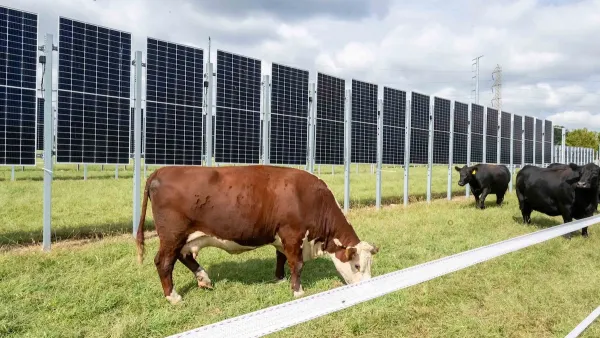The ambitious 6,000-acre project will combine an 800-megawatt solar farm with crop and livestock production.

Ohio state officials have approved a 800-megawatt solar project on 6,000 acres about 25 west of Columbus, the state’s capital. The Oak Run Solar project in Madison County will co-locate 4,400 acres of solar panels and storage with production of sheep and crops, a practice called agrivoltaics, reports the Columbus Dispatch. At a cost of $1 billion, it will be the largest project of its kind in the country, and produce enough electricity to power 170,000 homes and $8.2 million in annual tax revenue.
The Ohio Siting Board approved the project, which will be built on land partially owned by Bill Gates, though it was opposed by local officials, who said the project doubles the amount of prime farmland in the county that will be taken out of production because of solar uses. It’s a concern the practice of agrivoltaics seeks to mitigate by planting crops along the edges of solar fields and allowing livestock to graze between the panels. “In the first year of operation, Oak Run must graze at least 1,000 sheep and grow crops on 2,000 acres. Within eight years of operation, at least 70% of the farmable project area, or at least 4,000 acres, must include agrivoltaics,” reports Mark Williams for the Dispatch.
The development company, Savion, says construction could begin in 2025.
FULL STORY: Mega Madison County solar farm with Bill Gates connection wins Ohio approva

National Parks Layoffs Will Cause Communities to Lose Billions
Thousands of essential park workers were laid off this week, just before the busy spring break season.

Retro-silient?: America’s First “Eco-burb,” The Woodlands Turns 50
A master-planned community north of Houston offers lessons on green infrastructure and resilient design, but falls short of its founder’s lofty affordability and walkability goals.

Delivering for America Plan Will Downgrade Mail Service in at Least 49.5 Percent of Zip Codes
Republican and Democrat lawmakers criticize the plan for its disproportionate negative impact on rural communities.

Test News Post 1
This is a summary

Test News Headline 46
Test for the image on the front page.

Balancing Bombs and Butterflies: How the National Guard Protects a Rare Species
The National Guard at Fort Indiantown Gap uses GIS technology and land management strategies to balance military training with conservation efforts, ensuring the survival of the rare eastern regal fritillary butterfly.
Urban Design for Planners 1: Software Tools
This six-course series explores essential urban design concepts using open source software and equips planners with the tools they need to participate fully in the urban design process.
Planning for Universal Design
Learn the tools for implementing Universal Design in planning regulations.
EMC Planning Group, Inc.
Planetizen
Planetizen
Mpact (formerly Rail~Volution)
Great Falls Development Authority, Inc.
HUDs Office of Policy Development and Research
NYU Wagner Graduate School of Public Service





























